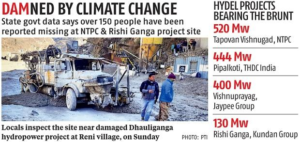In news : The sudden collapse of part of a glacier in Uttarakhand’s Nanda Devi mountain and the ensuing floods that have claimed many lives recently
What happened in Uttarakhand?
A significant slice of the glacier, dislodged by a landslide, according to some satellite images, produced roaring torrents in the Rishiganga and Dhauliganga rivers in Chamoli district, trapping unsuspecting workers at two hydro power project sites. Scores of people are still missing in the wave of water, silt and debris that swamped the rivers and filled tunnels in the Tapovan power project
What is the impact?
The incident has claimed many lives, including the hydro projects such as
- Tapovan vishnugad hydropower project
- The privately owned Rishi Ganga power project (130 Mw), which is on the upper stream of the Alaknanda river, was the first to face the brunt of the avalanche
- PipalKoti (4×111 Mw), the hydro project of state-owned THDC &
- Vishnuprayag (400 Mw) of Jaypee Group also faced damages.

What is an Avalanche?
An avalanche is an event that occurs when a cohesive slab of snow lying upon a weaker layer of snow fractures and slides down a steep slope
An avalanche is a rapid flow of snow down a hill or mountainside. Although avalanches can occur on any slope given the right conditions, certain times of the year and certain locations are naturally more dangerous than others.
Types of Avalanche
- Loose Snow Avalanche: They are common on steep slopes and are seen after a fresh snowfall
- Slab Avalanche: Loose Snow Avalanches in turn could cause a Slab Avalanche, which are characterized by the fall of a large block of ice down the slopes. Thin slabs cause fairly small amounts of damage, while the thick ones are responsible for many fatalities
- Powder Snow Avalanche: A mix of the other forms, Loose Snow and Slab. The bottom half of this avalanche consists of a slab or a dense concentration of snow, ice and air.
- Above this is a cloud of powdered snow, which can snowball into a larger avalanche as it progresses down the slope.
- The speed attained by this avalanche can cross 190 miles per hour and they can cross large distances.
Wet Snow Avalanche: These are quite dangerous as they travel slowly due to friction, which collects debris from the path fairly easily














